Understanding Machine Code vs. Bytecode
In the world of software engineering, code can take multiple forms from the time it's written by a programmer to the moment it is executed by a computer. What begins as high-level source code, written by humans in languages like Python or Java, this code eventually is eventually transformed into machine code – a sequence of 1s and 0s – that represent the lowest-level language a computer can read and execute. Often, an intermediary format called bytecode bridges the gap between high-level source code and machine code.
What is machine code?
Machine code is the most basic and fundamental level of code, designed to be directly read and executed by a computer's hardware. It is so low-level that it is neither human-readable nor accessible to higher-level systems. Machine code consists entirely of binary sequences – 1s and 0s – that correspond to specific commands or operations, instructing the computer's components (e.g., memory, CPU) on exactly what to execute.
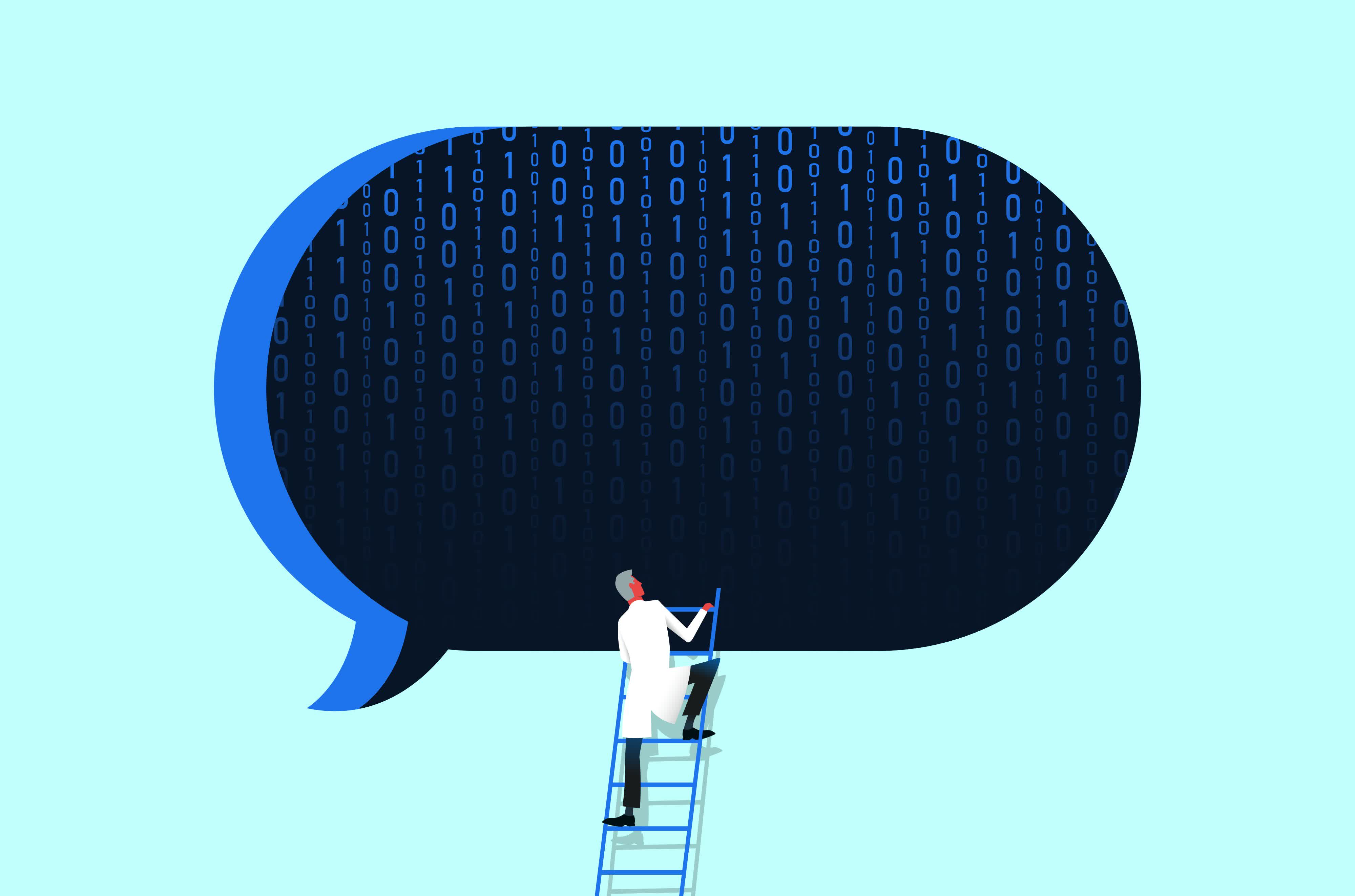
Editor's Note:
This guest blog was written by the staff at Pure Storage, an US-based publicly traded tech company dedicated to enterprise all-flash data storage solutions. Pure Storage keeps a very active blog, this is one of their "Purely Educational" posts that we are reprinting here with their permission.
High-level programming languages are typically translated into machine code through a process called compilation or assembly.
The primary role of machine code is to serve as the interface between software and hardware. It converts high-level programming languages (code you write in Java, C#, Python, etc.) into instructions a computer can understand and execute. Additionally, machine code forms the foundation for higher-level programming languages, as well as the compilers and interpreters used to create intermediary formats like bytecode, which will be discussed next.

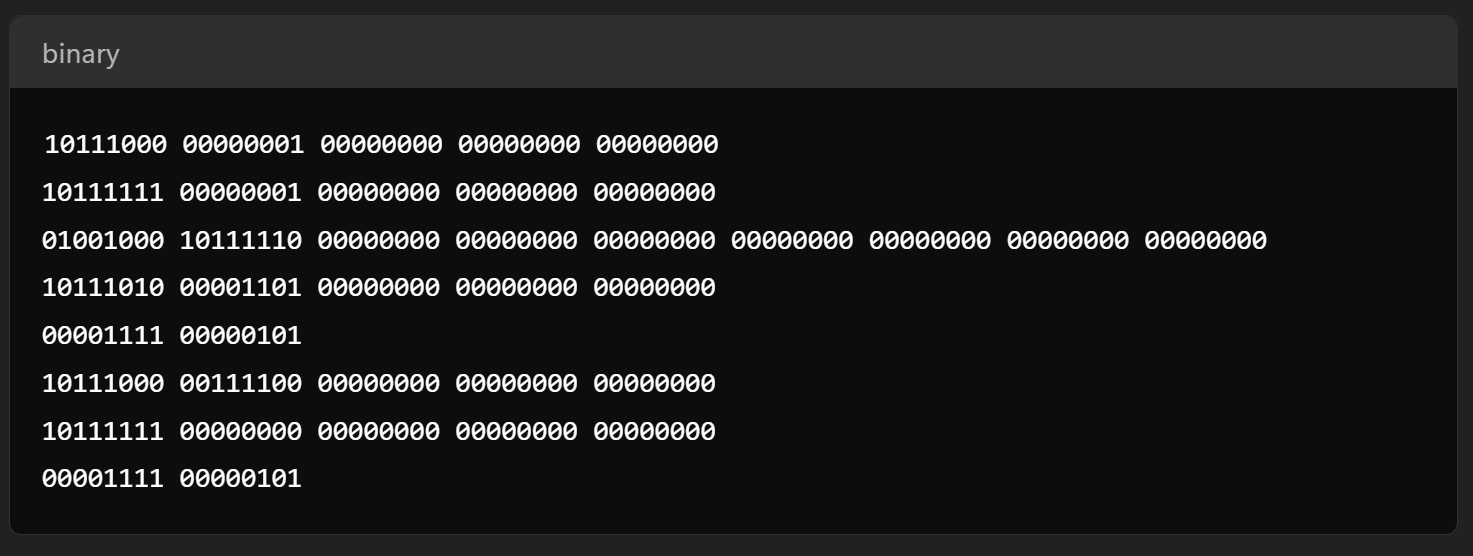
When software is written in a variety of programming languages, machine code ensures that high-level, human-readable commands are transformed into machine-readable instructions. Furthermore, machine code is optimized for the specific hardware it runs on, maximizing efficiency and performance.
Quick facts about machine code
- Machine code can directly interact with hardware components.
- Machine code is hardware specific, so it's tailored to the specific architecture of a computer's hardware, meaning that machine code written for one type of processor may not work on another.
- Machine code is not readable by humans and can be very complex. That's why high-level programming languages, which abstract away many steps, are required.
- Machine code instructions are executed directly by the CPU without any need for further interpretation or translation, making it extremely fast and efficient.
What is bytecode?
Bytecode is a compact, platform-independent, and portable version of high-level code. It's akin to a middle ground between source code and machine code: It's not readable by a human programmer like source code, but it's also not readable by hardware, like machine code. Instead, a compiler within a programming environment translates the source code into bytecode, which is then executed by a virtual machine or interpreter or compiled further.
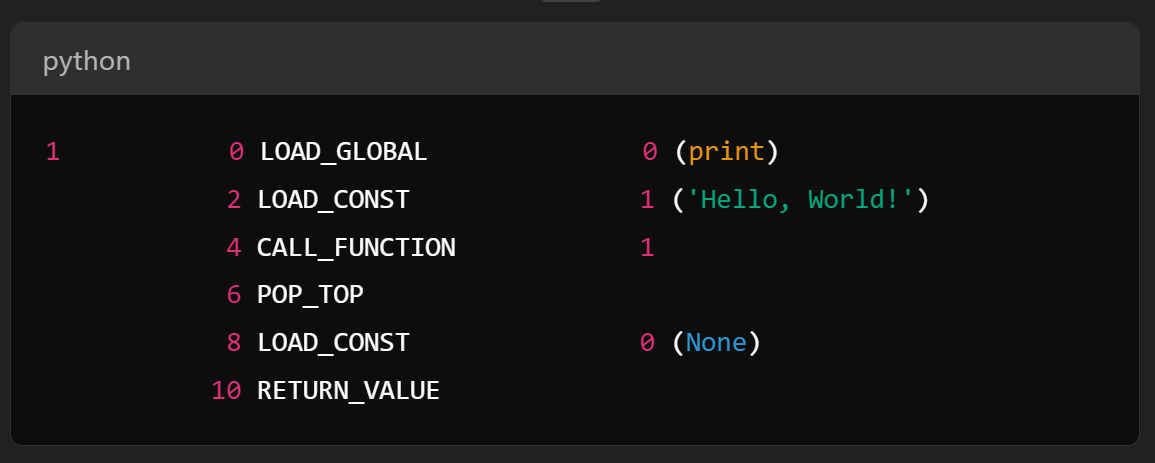
This distinction is important because modern software often needs to run on various devices, operating systems, and platforms. Bytecode enables this by providing a simplified, standardized representation of the source code in numeric form.
This format makes bytecode lightweight and portable, unlike machine code, which is often specific to a particular hardware architecture (e.g., a specific CPU). As long as a system has the appropriate virtual machine, it can execute the bytecode.
In simple terms, bytecode is a streamlined, compact version of a program written in a high-level programming language, such as Java or Python. However, it cannot be executed without a virtual machine or interpreter. Bytecode is also sometimes referred to as "p-code" (short for portable code).
Quick facts about bytecode
- Bytecode allows code to be run cross-platform and easier to interpret. As long as the system has the appropriate virtual machine (e.g., the Java Virtual Machine), the bytecode can be executed without modification.
- Bytecode can reduce hardware and operating system dependencies.
- Bytecode is not intended to be understood or written by humans; it is a numeric representation of the original source code.
- In software development, there will always be a trade-off between developer efficiency and program efficiency. The abstraction, while enabling greater flexibility and portability, can add overhead to a program, but just-in-time compilers can improve performance with more dynamic translation on the fly.
- Bytecode cannot run directly on hardware. It must first be interpreted by a virtual machine (e.g., the JVM for Java) or translated into machine code.
- Can be more complex and time-consuming to run testing, debugging, and diagnostics on bytecode. There's a lack of hardware control or optimization.
Why is machine code generally faster than bytecode?
Machine code is generally faster than bytecode because it is easier and quicker for a computer to process. This is primarily due to the absence of an abstraction layer, which is present in bytecode to simplify programming and compilation. While this abstraction layer makes code development more efficient for programmers, it often results in a trade-off in performance. Abstraction reduces the code's granularity and limits direct control over machine operations.
Machine code is closely aligned with the hardware's cache, memory, and other components, enabling software to be highly optimized for the specific hardware. Written in the computer's native language, machine code eliminates the need for additional interpretation. This means you are giving the machine exact instructions in the language specifically designed for it, resulting in minimal overhead and faster execution.
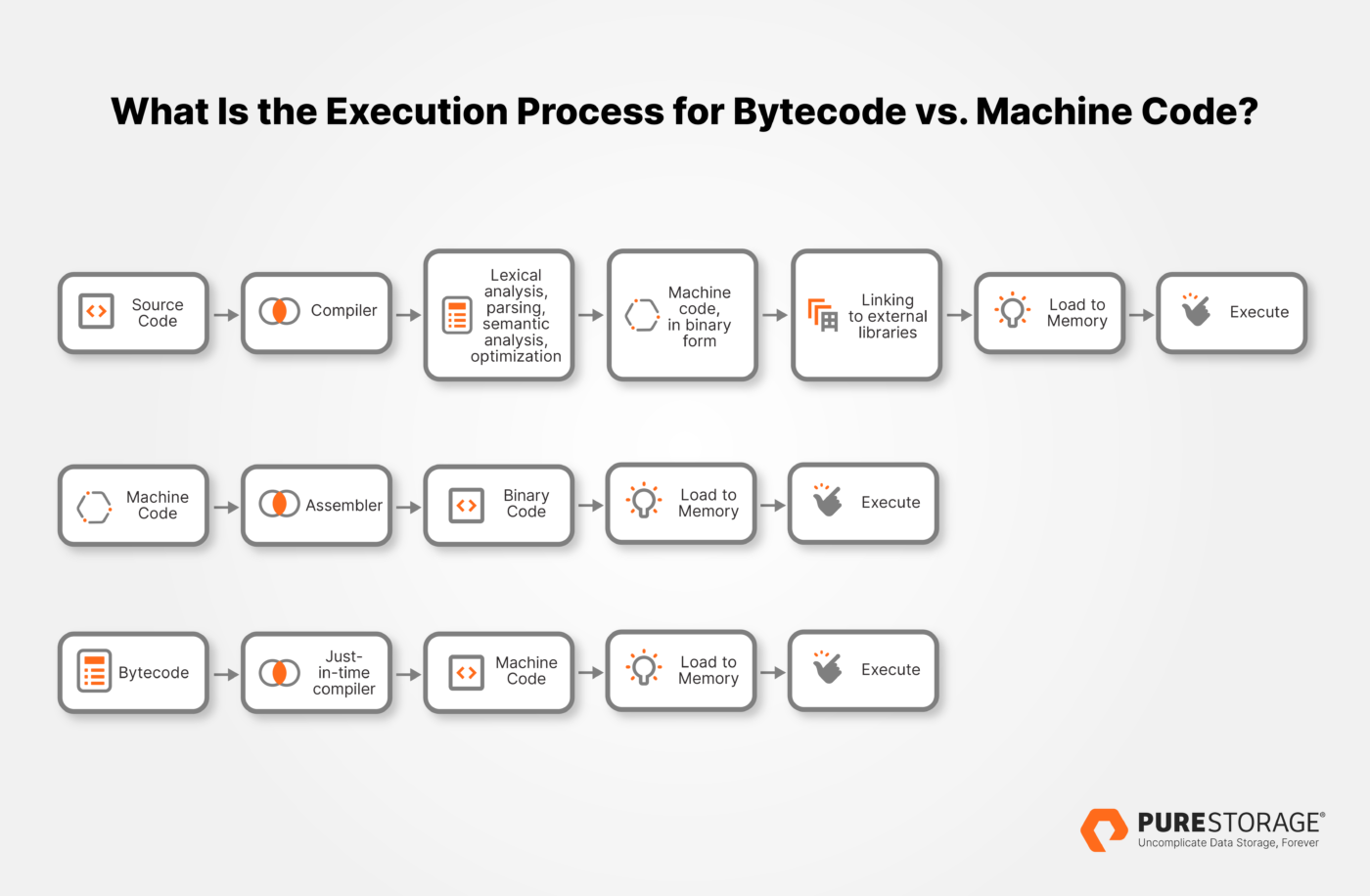
Bytecode, on the other hand, requires an additional layer of interpretation, which can introduce delays and complexity. Techniques like just-in-time (JIT) compilation can improve bytecode performance by converting it to machine code during runtime. However, machine code still benefits from superior hardware-level optimization.
A compiler that generates hardware-specific machine code can fully utilize the unique features of the hardware, whereas bytecode often cannot leverage these features as effectively.
Bytecode vs. machine code FAQ
Is binary the same as bytecode?
No, binary code is not the same as bytecode. While both are written in binary format (sequences of 1s and 0s), they serve different purposes:
- Binary codeis low-level and directly executable by a computer's hardware. It represents data and instructions in a language the machine can understand and act on. It is specific to the hardware it runs on. Machine code has almost no abstraction – it is designed to interact directly with hardware.
- Bytecode is intermediary code. Unlike binary code, it is not directly executed by hardware but rather processed by an interpreter or virtual machine. Bytecode is generated by a compiler from a high-level programming language (e.g., Java) and is optimized for portability and ease of interpretation.
Bytecode has a mid-level abstraction, closer to source code than to machine code. This abstraction makes bytecode easier to interpret across platforms, but it cannot directly interact with hardware without an interpreter.
Is .NET's CIL the same as bytecode?
Yes, the Common Intermediate Language (CIL) in Microsoft's .NET framework is a form of bytecode. Like Java, .NET operates on the principle of "write once, run anywhere." A compiler translates source code written in .NET languages into CIL instructions. These instructions can then be executed on any system with a compatible Common Language Runtime (CLR).

What is bytecode in Java?
Java is one of the most portable modern programming languages and bytecode is a cornerstone of this characteristic. When a Java application is compiled, the compiler generates bytecode instead of machine code.
When a Java application is written, it gets compiled and generates bytecode, which provides instructions to the JVM, which acts as an interpreter for each method in the Java program. The machine code it generates can be efficiently executed by the CPU.
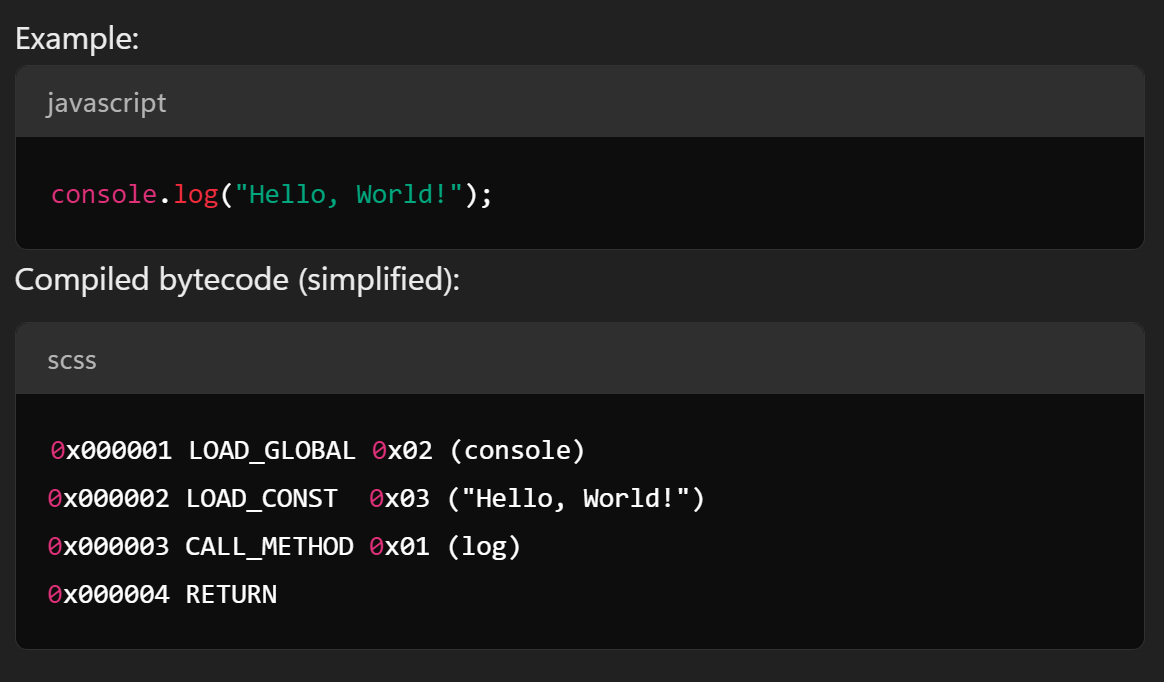
How do just-in-time compilers make bytecode more efficient?
Just-in-time compilers can help developers get the best of both worlds: the portability of high-level programming compiled into bytecode with the efficiency of machine code and better optimization of machine-specific features.
文章
2631
浏览
87
获赞
292
热门推荐
What to expect at WWDC 2020: Plenty of new features across all Apple devices
On June 22, Apple will hold is annual World Wide Developers Conference (WWDC). But rather than gatheNo, Fox News didn't get Trump to flash the White House lights on and off
How quickly in an era of malleable truth do tantalizing falsehoods make the rounds.On Friday, it wasChina is deleting posts about a kindergarten allegedly abusing its toddlers
As anger swells around a Chinese kindergarten accused of abusing its toddlers, online discussion aboGoogle launches augmented reality stickers for its Pixel phones
Need another reason to switch to Google's Pixel 2 phones? How about an augmented reality squad?UnveiApple gives students and teachers free AirPods with purchase of Mac or iPad
AirPods are cool. Free AirPods are even cooler. Apple is giving away a free pair of AirPods for studNeil Patrick Harris’ next project: His own channel for smart TVs
Want to know what your favorite celebrity is up to? These days it’s pretty straightforward: Fo'Irresponsible and irrational:' Aussie startups speak out on Muslim ban
President Donald Trump's Muslim travel ban caused chaos over the weekend, but the full reach of itsElon Musk teases what's next for Tesla in a year
Elon Musk, appreciates your business, Tesla owners.The Tesla, Inc. co-founder tweeted a brief year-eGmail's compose button on Android gets bigger, but only when you scroll down
Gmail's compose button is annoyingly small and unintuitive on phones. You may have not noticed it, bUK regulator: White male bank culture is ‘difficult to take'
The financial industry’s “white male” culture isn’t changing quickly enough,Teacher makes GoFundMe to 'buy' senator's vote on Betsy DeVos
UPDATE: Feb. 3, 2017, 3:02 p.m. EST A spokesperson for GoFundMe has informed Mashable that the "BuyProtesters take over bridges to send a message to Trump
It's finally Inauguration Day for President-elect Donald Trump but activists across the globe are haDark Sky mercifully gives Android users 1 more month until shutdown
Dark Sky has been sold to Apple, there's no changing that.However, Android users of the service willElon Musk just endorsed Trump’s secretary of state pick, and it makes no sense
Something strange is happening to Elon Musk. First, he joined President Donald Trump's orbit as a buUber announced a big deal — and it could mean driverless Mercedes at your door
Uber's next round of self-driving cars won't be owned by Uber at all — and the cars could be M
 科技创新!
科技创新!